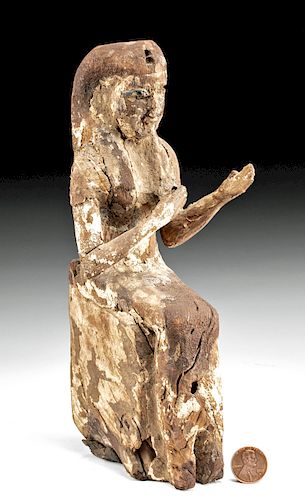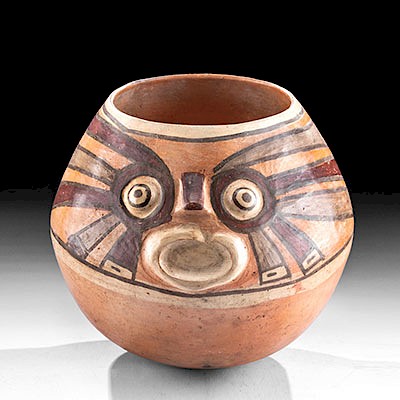Rare Egyptian Wood Isis w/ Bronze & Stone Eye
Lot 2a
About Seller
Artemis Fine Arts
686 S Taylor Ave, Ste 106
Louisville, CO 80027
United States
Selling antiquities, ancient and ethnographic art online since 1993, Artemis Gallery specializes in Classical Antiquities (Egyptian, Greek, Roman, Near Eastern), Asian, Pre-Columbian, African / Tribal / Oceanographic art. Our extensive inventory includes pottery, stone, metal, wood, glass and textil...Read more
Categories
Estimate:
$4,000 - $6,000
Absentee vs Live bid
Two ways to bid:
- Leave a max absentee bid and the platform will bid on your behalf up to your maximum bid during the live auction.
- Bid live during the auction and your bids will be submitted real-time to the auctioneer.
Bid Increments
| Price | Bid Increment |
|---|---|
| $0 | $25 |
| $300 | $50 |
| $1,000 | $100 |
| $2,000 | $250 |
| $5,000 | $500 |
| $10,000 | $1,000 |
| $20,000 | $2,500 |
| $50,000 | $5,000 |
| $100,000 | $10,000 |
| $200,000 | $20,000 |
About Auction
By Artemis Fine Arts
Dec 5, 2019
Set Reminder
2019-12-05 10:00:00
2019-12-05 10:00:00
America/New_York
Bidsquare
Bidsquare : Ancient / Ethnographic - Holiday Edition
https://www.bidsquare.com/auctions/artemis-gallery/ancient-ethnographic---holiday-edition-4710
What to give this holiday season? Ancient & Ethnographic Art of course! Our special Holiday auction features hundreds of unique finds from all over the world. Artemis Fine Arts info@artemisgallery.com
What to give this holiday season? Ancient & Ethnographic Art of course! Our special Holiday auction features hundreds of unique finds from all over the world. Artemis Fine Arts info@artemisgallery.com
- Lot Description
Ancient Egypt, Late to Ptolemaic Periods, ca. 712 to 30 BCE. An incredibly rare, well preserved wooden figure of the goddess Isis, Egyptian mother goddess, wife of Osiris and mother of Horus. Here, she is depicted seated on a throne, with her right hand holding her breast and her left arm extended - the figure would have once had a sculpture of the infant Horus held in her arms as she fed him. She also would have once had a Hathor crown of bronze placed atop her black wig, and the openings on the top of her head and forehead would have held it in place. White gesso on the exterior and traces of gilt that remain hint that the statue was once entirely painted gold. One of her eyes remains - with a delicate bronze outline and white and black stone creating the classic Egyptian-style look. Size: 3" W x 8.55" H (7.6 cm x 21.7 cm)
This style of statue, known as the "lactans pose" of Isis, was the most popular way to depict the goddess during the later centuries of pharaonic Egypt, indicating that during this time, she was valued as a mother and protector. Statues in this form were dedicated to cults in the goddess's name and placed in temples and shrines, including those associated with Osiris and Horus.
See a very similar wooden example retaining its crown at the Harvard Art Museum (1960.464) and a complete bronze example at the Metropolitan Museum of Art (45.4.4).
Provenance: private J.H. collection, Beaverton, Oregon, USA, acquired in the 1990s; ex-Tom Cederlind collection, Portland, Oregon, USA
All items legal to buy/sell under U.S. Statute covering cultural patrimony Code 2600, CHAPTER 14, and are guaranteed to be as described or your money back.
A Certificate of Authenticity will accompany all winning bids.
We ship worldwide and handle all shipping in-house for your convenience.
#149723Her crown is lost - see the Harvard Art Museum example referenced above for what she would have looked like with the crown. There was probably also once a sculpture of the infant Horus in her lap based on the placement of her hands. One eye is also lost. The wood is extensively weathered, but much of the original surface and pigment remains. Old collection number written in pencil on the back. Both arms have been repaired, but this is well done and difficult to see.Condition
- Shipping Info
-
All shipping is handled in-house for your convenience. Your invoice from Artemis Gallery will include shipping calculation instructions. If in doubt, please inquire BEFORE bidding for estimated shipping costs for individual items.
-
- Buyer's Premium



 EUR
EUR CAD
CAD AUD
AUD GBP
GBP MXN
MXN HKD
HKD CNY
CNY MYR
MYR SEK
SEK SGD
SGD CHF
CHF THB
THB















